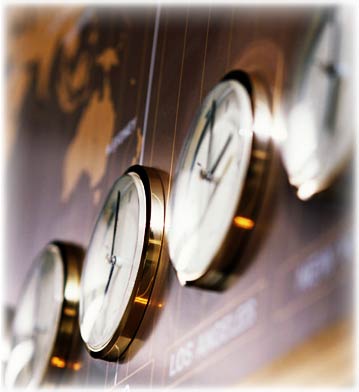Pursuing the Universal One Second
From ancient times, mankind has continued to pursue the accurate measurement of time. Around 3,500 B.C. ancient Egyptians built tall, stone monuments called obelisks to understand time by monitoring the shadow of an obelisk. Galileo Galilei found in the 16th century that a pendulum swings with a certain frequency. Pendulum clocks, applying this principle, were a precursor of time technology without dependence on natural phenomena. Technologies to make clocks were used to support the Age of Discovery and the Industrial Revolution. Modern life is supported by clocks using a quartz crystal oscillator as well as applications of atomic physics. Our project aims at dramatic improvement of clock technology, which has been nurtured by mankind.
What is the international definition of one second ?
One second had been defined astronomically based on the rotation and revolution of the earth. However, such movement of the earth, once assumed unchangeable, turned out to be gradually changing and found unfit to define time. Instead, currently, a second is defined by the oscillating phenomenon, i.e., radiation from atoms.
Highly Precise Atomic Clock
Atoms and molecules have a property to absorb and radiate light or electromagnetic wave of specific frequency. Cesium atoms absorb electromagnetic wave of a particular frequency called microwave. The cesium atomic clock defines one second as duration for counting 9,192,631,770 vibrations of this microwave. This has been adopted as the current definition of one second.
Limitations in Accuracy of Cesium Atomic Clock
Even this cesium atomic clock has uncertainty of 1 second for 30 million years. This is attributed to the thermal motion of the cesium atom as well as the collisions with other atoms, which may slightly change the microwave frequency that the atoms absorb. Making a new atomic clock to transcend this precision limitation requires an entirely new idea.


The Optical Lattice Clock,
a New Atomic Clock with a New Principle
In 2001, the research director of the ERATO Innovative Space-Time Project proposed a new kind of atomic clock, named an optical lattice clock, which far exceeds the precision of a conventional cesium atomic clock. This optical lattice clock measures the laser frequency that is absorbed by approximately one million atoms that are laser cooled and captured by optical lattices. Theoretically, this optical lattice clock makes an error less than one second after 13.8 billion years, in other words, the life of the universe.
Discovery of Magic Wavelength Lattice for Obtaining the Ultimate Level of Clock Precision
Making a super precision clock requires the freezing of atomic motion to minimize the Doppler effect. An optical lattice clock employs following two technologies.
(1) Laser Technology to Cool Atoms to the Extreme
In order to minimize the thermal motions of atoms, we have developed a narrow-line laser cooling technique to reduce atomic temperature close to absolute zero temperature, or -273.15 degrees Celsius.
(2) Magic Wavelength
An optical lattice clock confines atoms in optical lattices created by the interference pattern of laser beams. However, generally, containers of atoms, i.e., optical lattices, affect the eigen frequency of atoms, leading to lowering the performance of such an atomic clock. Dr. Katori discovered that the eigen frequency of atoms are not affected by the containers as long as the optical lattices are created by lasers with a specific wavelength. This particular wavelength is called Magic Wavelength.
ERATO Innovative Space-Time Project employs the state-of-the-art laser technology as well as quantum physics technology in addition to these new ideas to develop optical lattice clock with superb performance.
The Optical Lattice Clock Will Change the World
The passage of time is slightly different by place. This difference can be attributed to the distortion of space by the gravity of the earth. When the ultimate optical lattice clock is realized, this distortion of space that we have never before recognized may become visible in real time as the difference of time passage. For instance, by keeping a clock at a higher place, even by 1 centimeter, it would be possible to observe the quickening of the passage of time by reduced gravity. Applying this technology, we will be able to detect new underground resources or movements of the earth’s crust. Clocks, once conceived as a tool to share time with others, would be given a new role as a probe to sense the space curvature distorted by gravity.
In addition, the optical lattice clock has been adopted as one of secondary representation of the seconds, which are promising candidates for the future redefinition of a second. This clock under development in this project may change the definition of one second.






